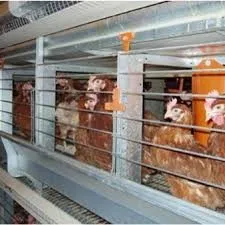Exploring Modern Chicken Cages for Enhanced Poultry Farming Efficiency
Nov . 07, 2024 16:53 Back to list
Exploring Modern Chicken Cages for Enhanced Poultry Farming Efficiency
The Importance of Poultry Chicken Cages in Modern Farming
Poultry farming is a significant part of the agricultural sector, especially in the production of chicken for meat and eggs. One of the pivotal components that determine the success and efficiency of poultry farming is the use of chicken cages. These cages are designed to provide a controlled environment for the birds, ensuring their health and boosting productivity. In this article, we will delve into the importance of poultry chicken cages, exploring their benefits, types, and the impact they have on both animal welfare and overall farm efficiency.
Benefits of Chicken Cages
1. Space Optimization One of the main advantages of using chicken cages is space optimization. In commercial poultry farming, the goal is to raise the maximum number of birds in a confined area. Cages facilitate vertical stacking, allowing farmers to significantly increase the number of hens per square foot compared to traditional floor systems.
2. Health Management Chicken cages help in better health management. By confining birds to cages, farmers can monitor them more effectively, reducing the risk of disease outbreaks. It is easier to observe the health of individual chickens and take prompt action when issues arise. This setup also limits exposure to pathogens that can thrive in free-range environments.
3. Feeding and Watering Efficiency Automated feeding and watering systems can be integrated into cage designs, ensuring that birds receive adequate nutrition with minimal waste. This automation not only saves time for farmers but also ensures that the chickens have constant access to food and water, promoting better growth rates and egg production.
4. Reduction of Aggression Certain breeds of chickens can exhibit aggressive behaviors, especially when kept in larger groups. Cages can help reduce dominance disputes, leading to a calmer environment which is vital for the overall welfare of the flock.
Types of Chicken Cages
There are various types of chicken cages used in poultry farming, each suited for different needs and production scales.
poultry chicken cage

1. Battery Cages These are the most common type of cages, primarily used in egg production. Battery cages typically hold multiple hens in a confined space but do not allow them to exhibit natural behaviors like nesting or perching. This has raised significant animal welfare concerns, leading to a gradual phase-out in several regions.
2. Enriched Cages In response to welfare issues associated with battery cages, enriched cages have been developed. These cages provide additional space, perches, and nesting boxes. They allow hens to engage in more natural behaviors, making them a preferable option from an animal welfare perspective.
3. Free-Range and Pastured Systems While not enclosed cages in the traditional sense, these systems offer birds outdoor access alongside a cage setup. They provide a balance between the benefits of cage confinement and the natural behaviors associated with free-ranging, appealing to consumers who prioritize animal welfare.
Impact on Animal Welfare
The debate surrounding poultry chicken cages often centers on animal welfare. Critics of traditional battery cages argue that these systems are inhumane as they restrict the bird's natural behaviors. Conversely, proponents argue that properly managed cages can lead to improved health and production outcomes.
The emergence of enriched cages represents an effort to strike a balance. These systems aim to respect both animal welfare and productivity, providing hens with the space and facilities necessary to express natural behaviors while still allowing them to be managed efficiently in a commercial context.
Conclusion
Poultry chicken cages have become an integral part of modern farming practices, offering numerous advantages from space efficiency to better health management. As the industry evolves, the focus continues to tilt toward finding solutions that balance productivity with ethical considerations regarding animal welfare. The introduction of enriched cages reflects a growing awareness and willingness to adapt farming practices for better outcomes. In the future, it is likely that innovations in cage design and management systems will further improve the relationship between agriculture and animal welfare, ensuring that poultry farming remains sustainable and responsible.
-
Hot Sale 24 & 18 Door Rabbit Cages - Premium Breeding Solutions
NewsJul.25,2025
-
Automatic Feeding Line System Pan Feeder Nipple Drinker - Anping County Yize Metal Products Co., Ltd.
NewsJul.21,2025
-
Automatic Feeding Line System Pan Feeder Nipple Drinker - Anping County Yize Metal Products Co., Ltd.
NewsJul.21,2025
-
Automatic Feeding Line System - Anping Yize | Precision & Nipple
NewsJul.21,2025
-
Automatic Feeding Line System - Anping Yize | Precision & Nipple
NewsJul.21,2025
-
Automatic Feeding Line System-Anping County Yize Metal Products Co., Ltd.|Efficient Feed Distribution&Customized Animal Farming Solutions
NewsJul.21,2025






